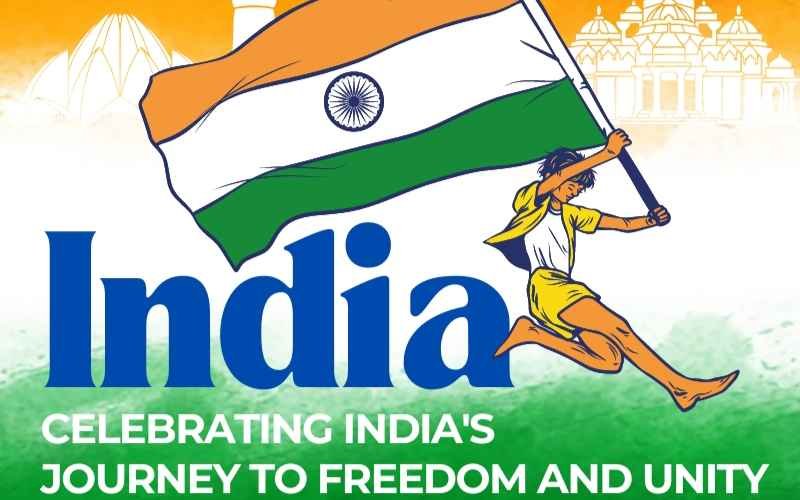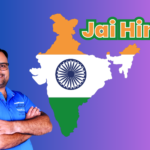Introduction
India’s Independence Day, observed each year on August 15th, commemorates a pivotal moment in the nation’s history when it finally emerged from the shadows of British colonialism after nearly two centuries of subjugation. The day is not merely a festive occasion but a profound reflection on the long and arduous journey towards freedom, characterized by the tireless efforts, sacrifices, and enduring spirit of countless Indians. These brave men and women, from all walks of life, united in their determination to reclaim their country’s sovereignty, facing immense challenges and making extraordinary sacrifices. Independence Day serves as a powerful reminder of their courage and the collective will of a nation that fought for and achieved the right to self-governance, laying the foundation for the India we know today. It is a day to honor the legacy of the freedom fighters and to reflect on the values of liberty, justice, and equality that continue to guide the country’s path forward.

The Struggle for Independence
India’s struggle for independence was a complex and multifaceted journey that spanned over a century, marked by a tapestry of resistance that ranged from peaceful civil disobedience to armed uprisings. The roots of this struggle can be traced back to the late 19th century when the growing discontent with British rule began to manifest in various forms of opposition, laying the groundwork for the freedom movement.
The Indian National Congress, formed in 1885, became a significant platform for voicing nationalist sentiments. Initially, its demands were moderate, seeking greater representation for Indians in government affairs. However, as the British response remained dismissive, the call for complete independence gained momentum. The early 20th century witnessed a shift in the freedom movement with the rise of leaders who would become the torchbearers of India’s quest for sovereignty.
Mahatma Gandhi emerged as a pivotal figure in the struggle, advocating for non-violent resistance, or Satyagraha. His philosophy of peaceful protest became the cornerstone of several major movements, including the Non-Cooperation Movement (1920-22), the Civil Disobedience Movement (1930-34), and the Quit India Movement (1942). These campaigns mobilized millions across the country, transcending barriers of caste, creed, and religion, uniting them in the common cause of freedom.
Parallel to the non-violent movement, there was also a strand of armed resistance. Leaders like Subhas Chandra Bose and revolutionaries such as Bhagat Singh, Chandrashekhar Azad, and others believed that only through direct confrontation and armed struggle could India achieve independence. Bose’s Indian National Army (INA), which sought to overthrow British rule with the support of Axis powers during World War II, exemplified the determination to fight for freedom by any means necessary.
Throughout these decades, the Indian freedom movement was characterized by its diversity—encompassing various ideologies, strategies, and leaders. The sacrifices were immense, with thousands of Indians enduring imprisonment, torture, and even death. Mass protests, strikes, and boycotts of British goods weakened the colonial economy and eroded the authority of the British Raj.
The struggle for independence was not just a political battle but a social revolution that sought to redefine Indian identity and unity. The participation of women, youth, and marginalized communities highlighted the inclusiveness of the movement. Leaders like Sarojini Naidu, Kasturba Gandhi, and others played vital roles in mobilizing support across the country.
Finally, after decades of relentless struggle, the British government, weakened by World War II and facing mounting pressure both in India and internationally, conceded to the demands for independence. On August 15, 1947, India was declared a free nation, marking the culmination of a long and grueling fight for sovereignty. The triumph, however, was bittersweet, as it was accompanied by the Partition, which led to the creation of Pakistan and unprecedented communal violence.
India’s path to independence is a testament to the resilience and determination of its people, a legacy that continues to inspire generations in the ongoing quest for justice, equality, and freedom.
Watch Video
Key Milestones Leading to Independence
The journey to India’s independence was marked by numerous key milestones that each played a crucial role in shaping the nation’s destiny. These events not only challenged British rule but also fostered a sense of unity and purpose among Indians, laying the foundation for the eventual achievement of freedom.
1857 – The First War of Independence
The First War of Independence, also known as the Sepoy Mutiny, was a watershed moment in India’s history. Sparked by a series of grievances among Indian soldiers (sepoys) in the British East India Company’s army, the rebellion quickly spread across northern and central India. While the revolt was ultimately unsuccessful in overthrowing British rule, it represented the first significant, organized resistance against colonial power. The uprising was characterized by fierce battles, widespread participation from different sections of Indian society, and notable leaders like Rani Lakshmibai of Jhansi and Bahadur Shah Zafar, the last Mughal emperor. Though the British suppressed the rebellion with brutal force, the events of 1857 sowed the seeds of nationalism and demonstrated that the British could be challenged, setting the stage for future struggles.
1885 – Formation of the Indian National Congress (INC)
The establishment of the Indian National Congress (INC) in 1885 marked the beginning of an organized political movement against British rule. Founded by A.O. Hume, a retired British civil servant, along with Indian leaders such as Dadabhai Naoroji and W.C. Bonnerjee, the INC initially sought to secure greater representation for Indians in the governance of their own country. Over time, however, the INC evolved into the principal leader of the Indian independence movement. It provided a platform for debate, dialogue, and the articulation of the aspirations of Indians across the country. The INC played a pivotal role in mobilizing the masses and led numerous campaigns for civil rights, self-governance, and eventually, complete independence from British rule.
1919 – Jallianwala Bagh Massacre
The Jallianwala Bagh Massacre in Amritsar on April 13, 1919, was a horrific event that galvanized the Indian freedom struggle. British troops, under the command of General Dyer, opened fire on a peaceful gathering of unarmed civilians, including women and children, who had assembled to protest against the repressive Rowlatt Act. The massacre resulted in the deaths of hundreds and the wounding of thousands more. This brutal act of violence outraged the Indian public and intensified the demand for independence. The massacre marked a decisive turning point, shattering the illusion of British benevolence and leading to widespread anger, protests, and a renewed resolve to end colonial rule. It also catalyzed Mahatma Gandhi’s shift towards a more radical stance, as he called for non-cooperation with the British authorities.
1930 – The Salt March
The Salt March, also known as the Dandi March, was a landmark event in India’s struggle for independence, symbolizing the power of non-violent resistance. Led by Mahatma Gandhi in March 1930, the 24-day, 240-mile march from Sabarmati Ashram to the coastal village of Dandi was a direct protest against the British monopoly on salt production and their taxation of this essential commodity. Upon reaching the coast, Gandhi and his followers made salt from seawater, openly defying British law. The Salt March inspired widespread civil disobedience across India, with millions participating in boycotts of British goods, protests, and demonstrations. The movement was instrumental in uniting Indians across diverse backgrounds in the fight against British rule, demonstrating the effectiveness of non-violent resistance and drawing global attention to India’s independence struggle.
1942 – Quit India Movement
The Quit India Movement, launched by Mahatma Gandhi on August 8, 1942, was one of the final and most significant campaigns for Indian independence. Gandhi’s call for immediate British withdrawal from India—embodied in the slogan “Do or Die”—resonated with millions of Indians who were eager to see an end to colonial rule. The movement quickly gained momentum, with widespread participation from people across the country. Strikes, protests, and acts of civil disobedience erupted nationwide, despite the British government’s harsh crackdown, which included mass arrests, censorship, and violence. Many leaders of the INC, including Gandhi, were imprisoned, but the movement persisted, driven by the indomitable spirit of ordinary Indians. The Quit India Movement marked a critical juncture in the struggle, as it became clear that British control over India was no longer tenable. The movement’s intensity and the British government’s inability to quell it effectively paved the way for negotiations that eventually led to India’s independence in 1947.
These key milestones, each representing a distinct phase of the freedom struggle, were instrumental in weakening the British Empire’s hold on India and galvanizing the Indian populace toward the ultimate goal of independence. They collectively reflect the resilience, determination, and unity of a nation striving to reclaim its destiny.
The Dawn of Independence
The dawn of India’s independence on August 15, 1947, marked the culmination of a long and arduous struggle against British colonial rule. It was a day of profound significance, filled with a mixture of joy, pride, and reflection as India stepped into a new chapter of its history. The momentous occasion was symbolized by the hoisting of the Indian tricolor at the Red Fort in Delhi, a powerful emblem of the nation’s newfound freedom and sovereignty.
On this historic day, Jawaharlal Nehru, who would become independent India’s first Prime Minister, delivered his iconic “Tryst with Destiny” speech to the Constituent Assembly. His words captured the essence of the moment, as he spoke of India’s awakening to life and freedom after centuries of bondage. Nehru’s speech was not just a declaration of independence but also a vision for the future, emphasizing the responsibilities that came with freedom—the tasks of nation-building, eradicating poverty and inequality, and ensuring justice for all citizens. His address resonated with the hopes and dreams of millions of Indians who had long yearned for this day.
As India celebrated its freedom, the subcontinent was simultaneously grappling with the painful reality of Partition. The decision to divide British India into two separate nations—India and Pakistan—was made hastily, leading to immense turmoil. The Partition was accompanied by one of the largest and most tragic mass migrations in history, as millions of people were forced to leave their homes and cross borders based on their religious identity. This mass exodus triggered widespread communal violence, resulting in the loss of countless lives and the uprooting of entire communities.
The joy of independence was thus tempered by the deep sorrow and suffering caused by Partition. Families were torn apart, and longstanding friendships between Hindus, Muslims, and Sikhs were shattered as the violence spiraled out of control. Cities like Lahore, Delhi, and Kolkata became epicenters of chaos and bloodshed. Despite the despair and dislocation, the people of India showed remarkable resilience, working tirelessly to rebuild their lives and communities in the face of overwhelming adversity.
The birth of independent India was a moment of immense pride, representing the triumph of a nation that had endured decades of oppression and exploitation. The resilience and unity of the Indian people were on full display as they came together to forge a new identity and a new nation. The leaders of the newly independent country, including Nehru, Sardar Vallabhbhai Patel, and Dr. B.R. Ambedkar, set about the monumental task of laying the foundations for a democratic and inclusive society. The adoption of the Constitution of India in 1950 was a critical step in this process, enshrining the principles of justice, liberty, equality, and fraternity that would guide the nation’s future.
India’s independence was not just the end of colonial rule; it was the beginning of a journey toward self-determination, development, and unity in diversity. The challenges that lay ahead were immense—addressing the needs of a vast and diverse population, fostering economic growth, and ensuring social harmony—but the spirit of independence provided the momentum to tackle these challenges head-on.
The dawn of independence on August 15, 1947, remains a defining moment in India’s history, a testament to the enduring spirit of its people and their unwavering commitment to freedom. It is a day remembered with pride, not just for the achievement of independence, but for the resilience, sacrifice, and unity that made it possible.
Celebrations and Significance
Independence Day in India is a day of immense national pride, celebrated with enthusiasm and reverence across the country. It is a time when the nation collectively reflects on its hard-won freedom and the values that underpin its democratic fabric. The celebrations on August 15th are a blend of tradition, patriotism, and a deep sense of gratitude toward those who sacrificed their lives for the country’s independence.
National Celebrations at the Red Fort
The most iconic celebration takes place at the Red Fort in Delhi, where the Prime Minister of India hoists the national flag, marking the start of the day’s events. This ceremony is not just a symbolic act but a deeply significant one, as it represents the sovereignty and unity of the nation. The Prime Minister’s address to the nation from the ramparts of the Red Fort is a key highlight of the day. In this speech, the Prime Minister reflects on the achievements of the past year, outlines the government’s vision for the future, and pays tribute to the freedom fighters who made independence possible. The speech often touches on key national issues, the progress made in various sectors, and the collective goals for the country’s development.
Following the flag-hoisting and speech, a grand parade showcases the cultural diversity, military strength, and technological advancements of India. The parade includes marching contingents from the armed forces, paramilitary forces, and various cultural troupes, all displaying a blend of India’s heritage and modernity. The event is attended by dignitaries, including foreign diplomats, and is broadcast live across the nation, allowing millions of Indians to partake in the celebrations from their homes.
Regional and Local Celebrations
Across India, Independence Day is marked by ceremonies and events in every state and union territory. Governors, chief ministers, and other local leaders preside over flag-hoisting ceremonies in state capitals and district headquarters, echoing the national celebration at the Red Fort. Schools and colleges across the country also participate actively in the festivities, with students and teachers coming together to honor the nation’s independence through cultural performances, speeches, and patriotic songs. Competitions such as essay writing, painting, and quizzes on India’s history and independence struggle are common, fostering a sense of pride and patriotism among the younger generation.
In villages and towns, the day is celebrated with equal fervor. Local communities organize events that include flag hoisting, processions, and cultural programs that highlight the region’s unique contributions to the national freedom movement. These events often serve as a reminder of the unity in diversity that characterizes India, bringing together people from different backgrounds to celebrate their shared identity as Indians.
The Deeper Significance
Beyond the parades, speeches, and ceremonies, Independence Day holds profound significance for every Indian. It is a day to honor the sacrifices of countless freedom fighters who laid down their lives for the cause of the nation’s sovereignty. Figures like Mahatma Gandhi, Bhagat Singh, Subhas Chandra Bose, and countless others are remembered and revered for their contributions to the freedom struggle. This day serves as a solemn reminder of the struggles endured to achieve independence and the responsibilities that come with it.
Independence Day is also a time for reflection on the values enshrined in the Indian Constitution—democracy, equality, justice, and liberty. It is a reminder of the responsibilities that come with freedom, particularly the duty to uphold these values in everyday life. As India continues to grow and evolve, Independence Day stands as a beacon of the nation’s aspirations and its commitment to building a just and equitable society.
For many, the day is also a moment to look forward, contemplating the future of the country. It is a time to renew commitments to the nation’s progress and to ensure that the ideals of freedom, as envisioned by the founders of modern India, continue to guide the nation’s journey. The celebration of Independence Day thus becomes an act of collective national introspection, a reaffirmation of the country’s democratic values, and a celebration of its rich cultural heritage.
A Day of Unity and Patriotism
Independence Day unites Indians across the globe, transcending regional, cultural, and linguistic differences. Whether in India or abroad, Indians everywhere come together to celebrate their shared history and identity. The day is marked by the display of the national flag, the singing of the national anthem, and various community events that strengthen the bond of unity among the people.
In essence, Independence Day in India is more than just a public holiday; it is a day of national importance that encapsulates the spirit of the nation. It is a celebration of freedom, a tribute to those who fought for it, and a day to recommit to the principles that define the Indian Republic. As the tricolor flutters in the sky, it serves as a powerful symbol of India’s enduring spirit, its achievements, and its unwavering commitment to the values of democracy and justice.
Conclusion
India’s Independence Day is more than just an annual celebration; it is a powerful reminder of the nation’s enduring commitment to freedom, unity, and resilience. The day honors the countless sacrifices made by those who fought for independence and serves as a beacon of hope and inspiration for future generations. As India marks 77 years of independence, it stands as a testament to the strength of its democratic ideals, the richness of its diversity, and the unwavering spirit of its people. Each Independence Day is an opportunity to reflect on the nation’s journey, celebrate its achievements, and renew the collective resolve to build a future that upholds the values of justice, equality, and liberty for all. As India continues to evolve on the global stage, this day remains a unifying force, reminding every Indian of the responsibility to safeguard and cherish the hard-won freedom that defines the nation’s identity.
Watch Video
FAQs
1. What is India’s Independence Day?
Answer: India’s Independence Day is celebrated on August 15th every year to commemorate the nation’s independence from British colonial rule in 1947.
2. Why is Independence Day important?
Answer: Independence Day marks the end of British rule in India and the birth of a sovereign nation. It honors the sacrifices of freedom fighters and serves as a reminder of the values of freedom, democracy, and unity.
3. Who was the first Prime Minister of independent India?
Answer: Jawaharlal Nehru was the first Prime Minister of independent India.
4. What is the significance of the Red Fort in Independence Day celebrations?
Answer: The Red Fort in Delhi is where the Prime Minister of India hoists the national flag and delivers a speech to the nation, making it the central site of Independence Day celebrations.
5. What was the “Tryst with Destiny” speech?
Answer: The “Tryst with Destiny” speech was delivered by Jawaharlal Nehru on the eve of India’s independence. It highlighted the significance of independence and outlined the vision for the nation’s future.
6. What is the national flag of India?
Answer: The national flag of India is a tricolor with three horizontal stripes of saffron (top), white (middle), and green (bottom), with a navy blue Ashoka Chakra (wheel) with 24 spokes in the center.
7. Why did Partition occur during India’s independence?
Answer: Partition occurred as a result of religious and political differences, leading to the creation of two separate nations—India and Pakistan—on the basis of religion.
8. How is Independence Day celebrated in India?
Answer: Independence Day is celebrated with flag-hoisting ceremonies, parades, cultural programs, and patriotic events across the country. The main event takes place at the Red Fort in Delhi.
9. What role did Mahatma Gandhi play in India’s independence?
Answer: Mahatma Gandhi was a key leader in the Indian independence movement, advocating for non-violent resistance against British rule. His leadership in movements like the Salt March and Quit India Movement was crucial in the struggle for freedom.
10. What is the significance of the Salt March?
Answer: The Salt March, led by Mahatma Gandhi in 1930, was a non-violent protest against the British monopoly on salt. It was a pivotal event in the Indian independence movement, uniting people across the country against colonial rule.
11. What happened on August 15, 1947?
Answer: On August 15, 1947, India gained independence from British rule, and the nation was officially declared sovereign. The same day also saw the creation of Pakistan.
12. Who designed the Indian national flag?
Answer: The Indian national flag was designed by Pingali Venkayya, an Indian freedom fighter and agriculturalist.
13. What is the Ashoka Chakra in the Indian flag?
Answer: The Ashoka Chakra is a navy blue wheel with 24 spokes, located in the center of the white stripe of the Indian flag. It represents the eternal wheel of law and dharma.
14. What are some key milestones in India’s struggle for independence?
Answer: Key milestones include the 1857 Revolt (First War of Independence), the formation of the Indian National Congress in 1885, the Jallianwala Bagh Massacre in 1919, the Salt March in 1930, and the Quit India Movement in 1942.
15. What is the Quit India Movement?
Answer: The Quit India Movement was a mass protest launched by Mahatma Gandhi in 1942, demanding an end to British rule in India. The movement was marked by widespread civil disobedience and became a significant step towards independence.
16. How do schools and colleges in India celebrate Independence Day?
Answer: Schools and colleges celebrate Independence Day with flag-hoisting ceremonies, cultural performances, speeches, and patriotic songs. Students participate in various activities that highlight the significance of the day.
17. What challenges did India face immediately after independence?
Answer: After independence, India faced challenges such as communal violence due to Partition, the task of integrating princely states, economic instability, and the need to establish a stable government and democratic institutions.
18. Who were some key leaders in the Indian independence movement?
Answer: Key leaders included Mahatma Gandhi, Jawaharlal Nehru, Subhas Chandra Bose, Sardar Vallabhbhai Patel, Bhagat Singh, and Dr. B.R. Ambedkar, among others.
19. What does Independence Day mean for modern India?
Answer: For modern India, Independence Day is a reminder of the nation’s hard-won freedom and a time to reflect on the progress made in democracy, economic growth, and social justice. It also serves as an opportunity to reaffirm the commitment to building a better future.
20. How do Indians abroad celebrate Independence Day?
Answer: Indians abroad celebrate Independence Day by participating in flag-hoisting ceremonies, cultural events, and community gatherings organized by Indian embassies, cultural organizations, and local Indian communities. These celebrations reflect their pride in their heritage and connection to India.
Related posts:
 Celebrating 77 Years of Freedom: A Message to All Indians Worldwide
Celebrating 77 Years of Freedom: A Message to All Indians Worldwide
 Unveiling the Heroism: Netaji Subhas Chandra Bose
Unveiling the Heroism: Netaji Subhas Chandra Bose
 India Marks 75th Republic Day with Grand Celebrations and Patriotic Fervor
India Marks 75th Republic Day with Grand Celebrations and Patriotic Fervor
 राम मंदिर को बढ़ावा: बिहार ने सीतामढ़ी में 50 एकड़ जमीन पर सीता मंदिर की अधिग्रहण
राम मंदिर को बढ़ावा: बिहार ने सीतामढ़ी में 50 एकड़ जमीन पर सीता मंदिर की अधिग्रहण
 Makar Sankranti: Embracing the Radiant Sun and Cultural Traditions
Makar Sankranti: Embracing the Radiant Sun and Cultural Traditions
 Kalpeni – A Tranquil Oasis in Lakshadweep
Kalpeni – A Tranquil Oasis in Lakshadweep
 Hanumangarhi Ayodhya: A Sacred Abode of Lord Hanuman
Hanumangarhi Ayodhya: A Sacred Abode of Lord Hanuman
 RCB vs RR: Who Goes Through If IPL 2024 Eliminator Gets Washed Out Due To Rain?
RCB vs RR: Who Goes Through If IPL 2024 Eliminator Gets Washed Out Due To Rain?
 5 Countries Celebrating Independence Day on 15 August Alongside India
5 Countries Celebrating Independence Day on 15 August Alongside India





